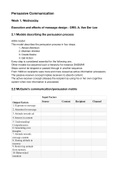Summary
Persuasive Communication Book and Micro Lecture Summary
- Course
- Institution
This summary of 78 pages contains all the necessary content from the book readings (Van der Pligt & Vliek, 2017) as well as the weekly micro lectures. It includes the most important theories and tables that are important for the literature review and exam.
[Show more]



